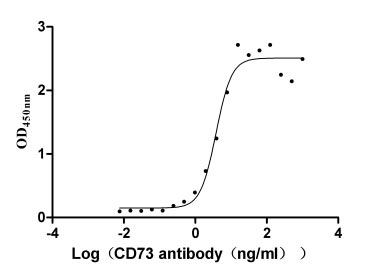Recombinant Podospora anserina Probable cysteine protease ATG4 (ATG4)
-
中文名称:Recombinant Podospora anserina Probable cysteine protease ATG4(ATG4),Yeast
-
货号:CSB-YP768242EXI
-
规格:
-
来源:Yeast
-
其他:
-
中文名称:Recombinant Podospora anserina Probable cysteine protease ATG4(ATG4),Yeast
-
货号:CSB-EP768242EXI
-
规格:
-
来源:E.coli
-
其他:
-
中文名称:Recombinant Podospora anserina Probable cysteine protease ATG4(ATG4),Yeast
-
货号:CSB-EP768242EXI-B
-
规格:
-
来源:E.coli
-
共轭:Avi-tag Biotinylated
E. coli biotin ligase (BirA) is highly specific in covalently attaching biotin to the 15 amino acid AviTag peptide. This recombinant protein was biotinylated in vivo by AviTag-BirA technology, which method is BriA catalyzes amide linkage between the biotin and the specific lysine of the AviTag.
-
其他:
-
中文名称:Recombinant Podospora anserina Probable cysteine protease ATG4(ATG4),Yeast
-
货号:CSB-BP768242EXI
-
规格:
-
来源:Baculovirus
-
其他:
-
中文名称:Recombinant Podospora anserina Probable cysteine protease ATG4(ATG4),Yeast
-
货号:CSB-MP768242EXI
-
规格:
-
来源:Mammalian cell
-
其他:
产品详情
-
纯度:>85% (SDS-PAGE)
-
基因名:ATG4
-
Uniprot No.:
-
别名:ATG4; Pa5D0009Probable cysteine protease ATG4; EC 3.4.22.-; Autophagy-related protein 4
-
种属:Podospora anserina (Pleurage anserina)
-
蛋白长度:full length protein
-
表达区域:1-500
-
氨基酸序列MKSTRSGSNN WQSAVSGTSP KIATAMEAAI SAGAEVSRVG RRILQRIWDP EPTNDRSNNE PVWCLGCSYL LDTKEYGTPP TLTTSTPPAD ATLTAIVPEP GAGVESEPRR ATEKAGVPVN TSNAKAVAPI PVAASGQHQL QVPETPPLSV ASSFDSALAY EEPGQDGGWP PAFLDDFESR IWMTYRTGFE VIPRSTDPKA AAALSFTMRF KTSFGDQTGF SSDTGWGCMI RSGQSLLANA MLISRAGRAW RRTTNPDIER EIVCLFADDP RAPYSIQNFV NHGAAACGKY PGEWFGPSAT ARCIHSLRVY LTRDLPEVYE DNFMSTANPD GNHFHPTLIL VSTRLGIDKI NPIYHEALIS TLQLPQAIGI AGGRPSSSHY FIGAQGQWLF YLDPHHPRPA LPYRENPNDY TIEELDSCHT RRLRHLHVED MDPSMLIGFL IKDEDDWDLW KSSVKHVQGK AIINVSPHDP EHGMGFGRAG AIDEVETLSD EDDTDTVLDL
-
蛋白标签:Tag type will be determined during the manufacturing process.
The tag type will be determined during production process. If you have specified tag type, please tell us and we will develop the specified tag preferentially. -
产品提供形式:Lyophilized powder
Note: We will preferentially ship the format that we have in stock, however, if you have any special requirement for the format, please remark your requirement when placing the order, we will prepare according to your demand. -
复溶:We recommend that this vial be briefly centrifuged prior to opening to bring the contents to the bottom. Please reconstitute protein in deionized sterile water to a concentration of 0.1-1.0 mg/mL.We recommend to add 5-50% of glycerol (final concentration) and aliquot for long-term storage at -20℃/-80℃. Our default final concentration of glycerol is 50%. Customers could use it as reference.
-
储存条件:Store at -20°C/-80°C upon receipt, aliquoting is necessary for mutiple use. Avoid repeated freeze-thaw cycles.
-
保质期:The shelf life is related to many factors, storage state, buffer ingredients, storage temperature and the stability of the protein itself.
Generally, the shelf life of liquid form is 6 months at -20°C/-80°C. The shelf life of lyophilized form is 12 months at -20°C/-80°C. -
货期:Delivery time may differ from different purchasing way or location, please kindly consult your local distributors for specific delivery time.Note: All of our proteins are default shipped with normal blue ice packs, if you request to ship with dry ice, please communicate with us in advance and extra fees will be charged.
-
注意事项:Repeated freezing and thawing is not recommended. Store working aliquots at 4°C for up to one week.
-
Datasheet :Please contact us to get it.
靶点详情
-
功能:Cysteine protease required for the cytoplasm to vacuole transport (Cvt) and autophagy. Required for selective autophagic degradation of the nucleus (nucleophagy) as well as for mitophagy which contributes to regulate mitochondrial quantity and quality by eliminating the mitochondria to a basal level to fulfill cellular energy requirements and preventing excess ROS production. Cleaves the C-terminal amino acid of ATG8 to reveal a C-terminal glycine. ATG8 ubiquitin-like activity requires the exposure of the glycine at the C-terminus for its conjugation to phosphatidylethanolamine (PE) and its insertion to membranes, which is necessary for autophagy. The ATG8-PE conjugate mediates tethering between adjacent membranes and stimulates membrane hemifusion, leading to expansion of the autophagosomal membrane during autophagy. Moreover not only conjugation, but also subsequent ATG8-PE deconjugation performed also by ATG4 is an important step required to delipidate ATG8 to release the protein from membranes, which facilitates multiple events during macroautophagy, and especially for efficient autophagosome biogenesis, the assembly of ATG9-containing tubulovesicular clusters into phagophores/autophagosomes, and for the disassembly of PAS-associated ATG components. ATG8 delipidation by ATG4 also recycles ATG8-PE generated on inappropriate membranes to maintain a reservoir of unlipidated ATG8 that is required for autophagosome formation at the PAS.
-
亚细胞定位:Cytoplasm. Nucleus.
-
蛋白家族:Peptidase C54 family
Most popular with customers
-
Recombinant Human Tumor necrosis factor receptor superfamily member 5 (CD40), partial (Active)
Express system: Mammalian cell
Species: Homo sapiens (Human)
-
Recombinant Human 5'-nucleotidase (NT5E) (Active)
Express system: Mammalian cell
Species: Homo sapiens (Human)
-
Recombinant Human Cytokine receptor common subunit beta (CSF2RB), partial (Active)
Express system: Mammalian cell
Species: Homo sapiens (Human)
-
Recombinant Human E3 ubiquitin-protein ligase ZNRF3 (ZNRF3), partial (Active)
Express system: Mammalian cell
Species: Homo sapiens (Human)
-
Recombinant Human Angiopoietin-2 (ANGPT2) (Active)
Express system: Mammalian cell
Species: Homo sapiens (Human)
-
Recombinant Human Somatostatin receptor type 2 (SSTR2)-VLPs (Active)
Express system: Mammalian cell
Species: Homo sapiens (Human)
-
Recombinant Human Microtubule-associated protein tau (MAPT) (Active)
Express system: Mammalian cell
Species: Homo sapiens (Human)
-
Recombinant Human Complement component C1q receptor (CD93), partial (Active)
Express system: Mammalian cell
Species: Homo sapiens (Human)






-AC1.jpg)

-AC1.jpg)











